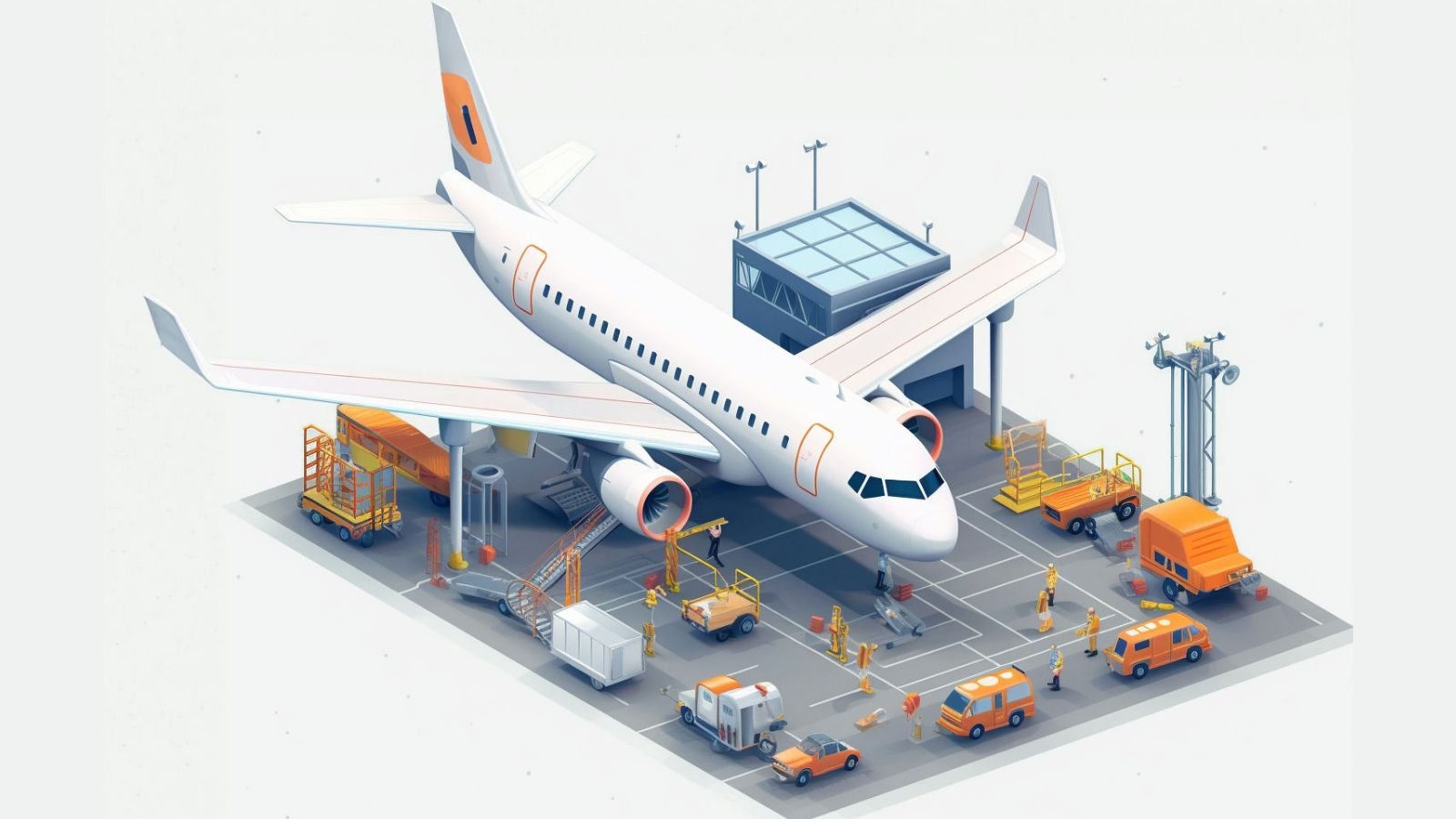As the aviation sector continues its forward momentum, the transformative technology shifts aren't limited to just the airline retail experience we highlighted in our recent Airline Tech Transition Report.
There's another core segment of the airline ecosystem that's pivotal to its efficient functioning – airline operations.
Within the complex realm of airline operations, three pivotal areas stand out, each undergoing significant innovative overhauls that are reshaping traditional operational methods:
- Ramp Terminal Operations: Preparing the aircraft for its next journey.
- Flight Operations: Managing the aircraft while it's in the air.
- Post-Flight Operations: Streamlined management of luggage post-landing.
In this analysis, we'll take a closer look at the first of these critical areas – Ramp Terminal Operations – exploring its nuances and understanding its evolving role in the broader operational landscape of airlines.
.png?width=750&height=422&name=Slide1%20(1).png)
RAMP TERMINAL OPERATIONS: RACING AGAINST TIME
In the aviation world, the clock is always ticking!
Each minute holds monumental value, especially when aircraft are grounded. As the famous airline saying goes: planes don't make money sitting on the ground. The essence of an efficient airline operation lies in how promptly it can prepare an aircraft for its next journey – all while maintaining the highest safety standards and ensuring top-notch service.
As the airline industry constantly evolves, so do the methods and technologies that support it. Today, the emphasis on efficient Ramp Terminal Operations isn't just about manual precision but about leveraging cutting-edge technologies to ensure seamless operations.
The intricate dance that constitutes Ramp Terminal Operations revolves around swift yet organized coordination. This process isn’t merely about restocking amenities or refueling the aircraft. It involves orchestrating a multitude of stakeholders, for example, the strategic alignment between an airline’s fleet planning, schedule planning, passenger reservations, in-flight and ground operations, and especially airplane maintenance systems. Furthermore, this coordination extends to interactions with external entities such as air traffic controllers, airport authorities, and control authorities like immigration and customs. These latter elements add significant uncontrollable factors to the process, contrasting with the aspects airlines can control. This dichotomy between controllable and uncontrollable aspects is a critical consideration in the efficiency and success of the turnaround process.
As a result of this complexity, a single turnaround typically consists of hundreds of individual tasks, involving more than 75 different people and entities.
So, what drives this push for optimizing turnaround times, especially in today's rapidly evolving aviation landscape?
Let's dive into the three pivotal reasons that are more urgent now than ever before, underscoring the importance of shaving off every possible minute from the aircraft turnaround process.
WHY MINIMIZING TURNAROUND TIMES IS PARAMOUNT
Before an aircraft embarks on its next journey, it undergoes a crucial period of preparation. First, it remains stationed at the gate, allowing passengers to disembark, cargo and baggage to be unloaded, and necessary services, including refueling, cleaning, catering, and maintenance to be performed. Following this, cargo and baggage are loaded afresh, and a new set of passengers board. The time this cycle takes, averaged over numerous trips, is what the industry denotes as 'average turn-time'.
These average turn-times are constantly under pressure to be kept as short as possible.
Let’s briefly explore why.
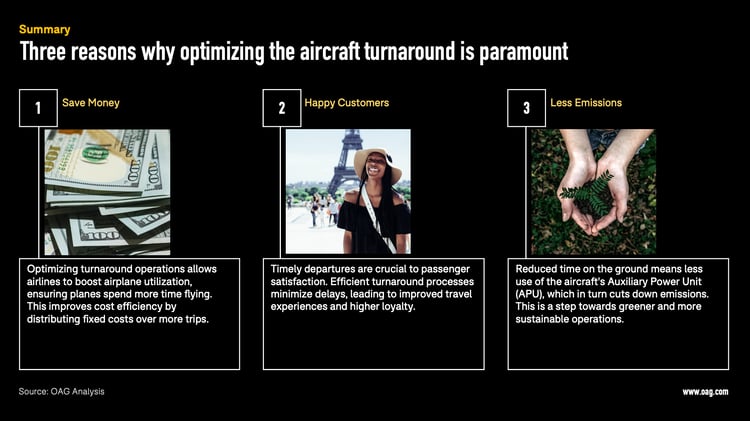
1. THE ECONOMIC IMPERATIVE OF EFFICIENT TURNAROUND
For airlines, time is money – quite literally. An airplane on the ground is usually an asset not generating revenue. Thus, the quest for minimizing average turn-time isn't merely operational but fundamentally economic.
This is especially true for low-cost airlines that rely heavily on quick turnarounds for efficient operations. However, it's important to note that for many legacy carriers, the equation can be more nuanced. For them, scheduling optimal connectivity in their hub-and-spoke systems often takes precedence. Additionally, in some cases, aircraft may need to remain on the ground for extended periods due to time differences and specific flying patterns. Thus, while efficient turnaround is universally valuable, its impact and implementation can vary significantly between different types of carriers.
In the case of budget airlines, the foremost consideration is airplane utilization. Especially for carriers championing point-to-point routes and those with shorter average trip lengths, efficient utilization is a key necessity. Such carriers typically adopt a streamlined approach: they employ a simplified fleet structure, limit airplane types, and emphasize high airplane utilization.
This lean operational model offers dual benefits:
- Firstly, with a limited variety of airplanes, swapping out an aircraft in case of unforeseen technical glitches becomes smoother.
- Secondly, elevated airplane utilization allows these airlines to distribute their fixed ownership expenditures across a larger number of flights, effectively diminishing costs on a per-seat-mile or per-trip basis.
Research carried out by Boeing (see graph below) crystallizes the economic significance of reducing turn-times. By shaving off a mere 10 minutes from the average turn-time (reducing it from 40 to 30 minutes), airplane utilization surges by an impressive 8% for a typical point-to-point carrier.
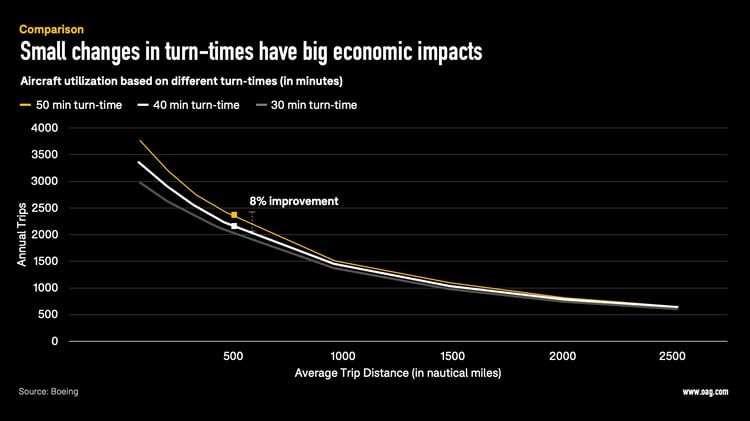
While the advantages of decreased turn-times are clear, assigning an exact monetary value to such reductions is challenging. Grounding costs are influenced by a myriad of factors, from the specifics of aircraft financing and aircraft type to variables like route specifics, fuel prices, load factors, and more.
While it's challenging to pinpoint an exact financial figure, the economic rationale for minimizing turn-times remains unquestionable. As such, the push for enhancing efficiency in turnaround operations is primarily about profitability.
2. The Passenger's Perspective on Turnaround Times
While airlines grapple with the economics of turnaround times, passengers are primarily concerned with another facet: punctuality.
Punctuality is not just about the flight departing and arriving on time. For many travelers, especially those on connecting flights, punctuality is crucial for ensuring connectivity. A delay in one segment can have a ripple effect, potentially causing passengers to miss their connecting flights and disrupting carefully planned itineraries. Therefore, maintaining strict adherence to scheduled turnaround times is essential not just for economic reasons and operational efficiency but also for ensuring that passengers can reliably reach their destinations or make their connecting flights without undue stress.
According to our proprietary OAG Flight Status Data, while a delay of about six minutes in planned turnaround can often be recuperated at some stage during a flight, anything beyond this window typically culminates in agonizing delays.
Data from our OAG analysis in March 2023 provides the regularity of this issue.
- Alarmingly, none of the major US airlines consistently achieved their aircraft turnarounds within the projected timeframes.
- United Airlines was the lone contender that managed to keep the variance within the six-minute gap between planned and actual turnaround times.
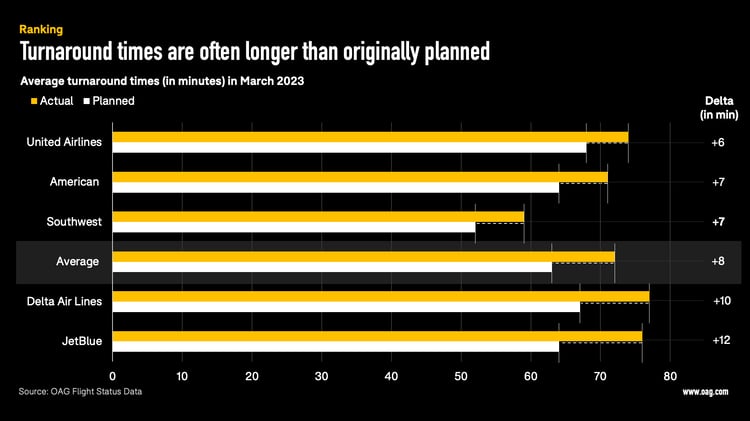
Our findings from March, while indicative, represent only a high-level view given the small sample size of 10 airports and 25 airlines. However, they do align with larger industry trends observed across various markets. According to the 2023 Turnaround Benchmark Report, the average ground delay, even among the best-performing short-haul airlines in the world (categorized as those in the top 75th percentile in terms of turnaround time), is an alarming eight minutes. This statistic highlights the significant challenges that even the most efficient airlines face in optimizing turnaround times.
What does all this mean for the average traveler?
Simply put, disruptions and discomfort.
- Recent studies indicate that flight delays feature prominently among the top three frustrations that air travelers complain about.
- Frost & Sullivan estimates that a 1% reduction in on-time performance in a given year results in a reduction of up to 0.6% of an airline’s net promoter score.
Thus, streamlined and punctual turnaround times aren't just an economic necessity – they're a core pillar of customer satisfaction. This holds true for all carriers, spanning the spectrum from short-haul point-to-point providers to long-haul legacy specialists.
3. The Green Angle of Turnaround Times
The call for sustainability is bellowing louder than ever, especially in the airline industry.
As stakeholders and passengers push for a “greener” travel experience, airlines are compelled to scrutinize every facet of their operations, from in-flight procedures to on-ground activities.
While the main engines might be silent during the turnaround, the aircraft is far from inactive. An essential player here is the aircraft's Auxiliary Power Unit (APU), typically nestled in the tail cone. Even with the main engines switched off, the APU runs, providing vital electrical and mechanical power. This includes maintaining air conditioning, powering essential cockpit systems, and eventually aiding in restarting the main engines.
While the APU serves a pivotal role, it’s not without its environmental footprint. Every minute of delay in turnaround times adds to the APU's operational duration. While the emissions might seem minor in isolation, they accumulate rapidly.
- Reducing each flight's turnaround time by just a single minute, thus cutting APU runtime, can lead to a CO2 reduction of over 3 kg – a seemingly modest amount.
- But when projected across the anticipated 32 million flights in 2023, this translates to a staggering industry-wide savings of over 172 million kg of CO2.
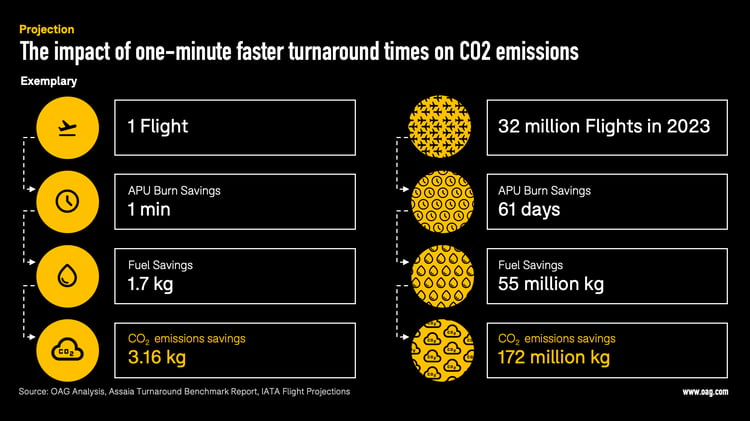
Recent research supports this savings potential:
- The Turnaround Report finds out that among the 25% least efficient airlines in terms of turnaround management, an average of 16 minutes of additional APU operation equates to a burn of approximately 27kg of extra fuel, translating to over 85kg of additional CO2 emissions.
- This Transport and Environment Study illuminates that accurate departure time forecasts would significantly trim down unnecessary APU emissions, reinforcing the importance of a tight turnaround schedule.
Notably, this carbon footprint could be effortlessly sidestepped if turnaround times adhered closely to the plan – no revolutionary electric or hydrogen-based jet engine needed.
So while many view sustainability through the lens of in-flight practices only, the significance of ground operations cannot be ignored. After all, every saved minute on the ground is a stride toward a greener tomorrow.

THE TECH BEHIND PERFECTING TURNAROUND TIMES
To appreciate the transformative potential of faster turnaround times, it's vital to evaluate how these improvements can be realized consistently and safely. The fusion of innovation and technology is the keystone to this advancement. This journey of innovation unfolds in three distinct phases:
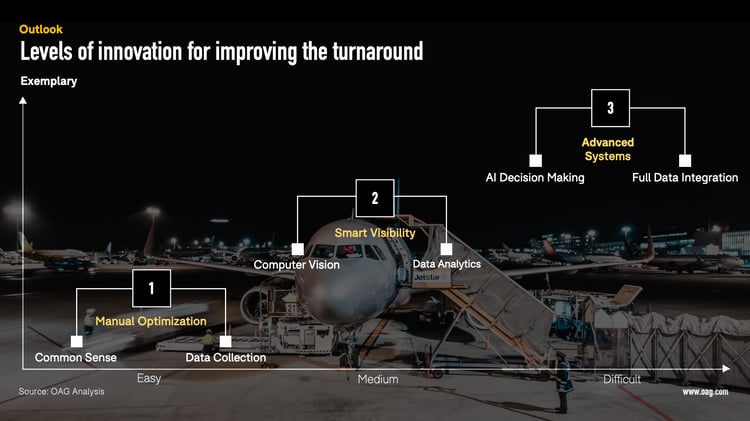
1. MANUAL OPTIMIZATION
At its core, this is about refining and rigorously standardizing turnaround processes. A consistent and clearly defined approach to turnaround processes like cleaning, cargo handling, and passenger boarding can significantly smooth operations. The more these processes are repeated, the more streamlined they become. This is when little windows of opportunity for improvement show up.
One compelling example showcases Delta Airlines' awareness: it tweaked the angle at which aircraft are pushed away from the gate. A shift from 90 degrees to 45 degrees saved the company just a minute or two each time, but these small increments, over time, prove monumental, as we learned above.
There are many other straightforward ideas to augment this efficiency further. While these manual optimizations are invaluable, they offer only limited upside potential. For more transformative shifts, technology-led innovation is imperative.
2. Smart Visibility
This second phase is anchored in leveraging today’s technology to keep a vigilant eye on ongoing processes and to enhance planning. A notable example is AeroCloud, which boosts its Airport Management Systems by combining flight data from multiple sources. This ensures a real-time, up-to-date single source of truth around flight activities, facilitating better planning for upcoming turnarounds.
Employing computer vision allows for real-time operational monitoring, flagging any deviations from optimal performance. Springshot is such a case in point. Developed in 2011, Springshot is an operations platform that provides aviation managers and planners with a unified control panel for smooth daily operations. By integrating our OAG data, Springshot equips airports and airlines with tools for accurate and balanced resource distribution. Its systems, fueled by automation, integrations, and AI, help save millions of dollars by preventing delays.
Assaia, a travel-tech startup from Switzerland, is another powerful example. The company’s partnership with airports, like the one in Halifax, Canada, employs a synergy of Artificial Intelligence and computer vision. Its solution can, for example, assist in efficient de-icing processes, a frequent cause of delays. By integrating data from the gates, the de-icing pad, and other essential inputs, the technology facilitates better coordination, minimizing blockages. Assaia's tech suite, with its real-time alerts and event detection capabilities, claims over 12% turnaround time improvements.
Other tech giants, including IBM, have also channeled their expertise into the turnaround domain, creating unified platforms to enhance collaboration and streamline operations. An array of tech solutions, from emerging startups like Aerogility and EXSYN to long-time tech pioneers like Honeywell and IBS Software, are also making waves in this space. Not to mention airline-owned solutions such as those from Lufthansa Systems.
What all these examples have in common is that they lie at the intersection of data, people, and technology, making sense of the data and connecting the right people.
3. The AI-Driven Future
The journey of innovation in airline operations is steadily integrating AI technologies, not only for monitoring and detecting but also for proactive adjustments that enhance operational efficiency.
A prime example of this unfolding AI future is the “Deep Turnaround” system at Amsterdam Schiphol Airport (AMS). This AI-driven solution, equipped with cameras, tracks over 70 steps in the aircraft turnaround process to predict its duration and estimate when a plane is ready to push back from the gate. Although still in its early stages, “Deep Turnaround” has already shown positive results and is not limited to Schiphol. Recently, it was revealed that this system is also being tested at other airports, including Eindhoven Airport.
With this in mind, imagine the expansive potential of such technology. For instance, an AI system could use real-time weather updates to foresee delays and automatically redirect fuel or cargo handling to another aircraft due for an imminent departure. This proactive adaptation ensures no time is wasted, resources are optimally utilized, and the integrity of the flight schedule is maintained. These advancements signal a future where AI not only tracks and reports but dynamically orchestrates operational decisions, leading to more efficient, timely, and sustainable airline operations.
This future vision underscores a seamless, automated ecosystem where every piece of data is not just collected but also actioned upon in real-time, ensuring optimal turnaround efficiency.
In wrapping up, it's clear that the most effective solutions for airlines emerge from the synergy of innovation, data, and technology. These elements serve as invaluable aids to dispatchers and movement controllers, offering enhanced visibility and informed decision-making. However, it's important to recognize that while these advancements significantly assist operational processes, they are not replacements for human insight. Commercial considerations and other critical factors still require human oversight and intervention. As the airline industry continues to evolve, the adept management of turnaround times, augmented by these technological aids, will play a crucial role in determining its future course and success.


